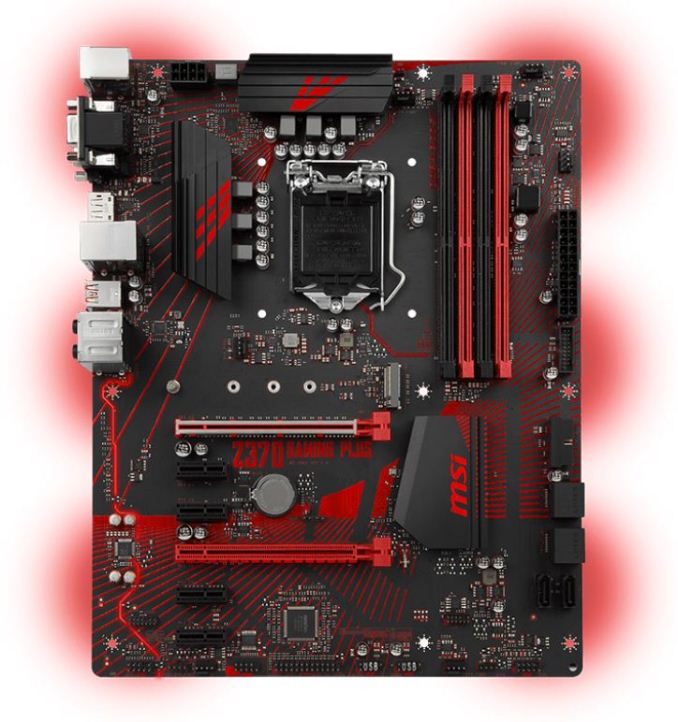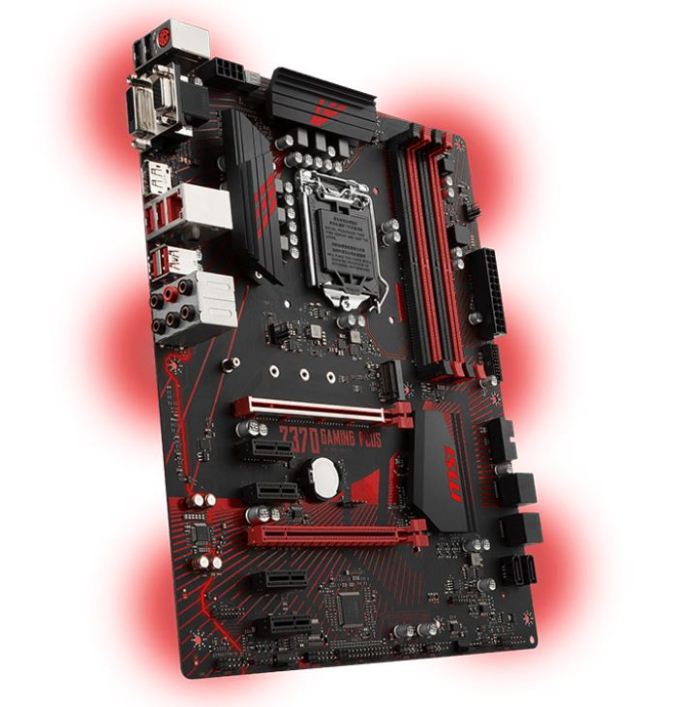Analyzing Z370 for Intel's 8th Generation Coffee Lake: A Quick Look at 50+ Motherboards
by Ian Cutress, Anton Shilov, Joe Shields & Gavin Bonshor on October 20, 2017 2:00 PM ESTMSI Z370 Gaming Plus
The Z370 Gaming Plus fits in the lower end of the MSI Z370 Gaming lineup by taking away a few key items on the other boards. Notably, the only LEDs are the board are located on the back of the board and the audio separation line; they are also only red rather than full RGB. The theme is pretty specific, being black and red, so the red LEDs do match the aesthetic. Other notable changes include full-length PCIe slot count reduced to 2, as well as the VRM section trimming a few phases. For the most part, that only excludes users who wish to run three PCIe coprocessors. Regardless of the changes, it is still a well-appointed board.
The Gaming Plus is a standout aesthetically due to its permanent black and red design. A wave of thin red lines penetrate their way through the bottom third of the board through the PCI slots and up through the VRM heatsinks, looking like a laser show, but in red only. Additionally, the memory slots alternate black and red with both full-length PCIe slots donned in red. The Gaming Plus does have one RGB LED connector in case users want to add more red, or a bit more color to their case.
The board uses four memory slots with double sided clips, supporting 64GB at maximum capacity with speeds up to DDR4-4000. The Gaming Plus has two full-length PCIe slots, with the primary slot reinforced and running a full PCIe 3.0 x16 from the processor. The second full-length slot, in red, supports x4 connectivity from the chipset, along with four black PCIe x1 slots also on the board.
The board has the normal complement of six SATA ports. Four of the ports are oriented horizontal, while the other two directly next to them are vertical to the board. Other storage options include one M.2 slot fitting up to a 110mm module, and it supports both PCIe and SSD based devices. The board is wired so that SATA1 port is disabled when an M.2 SATA SSD is installed.
Users will find six 4-pin fan headers located throughout the board. Like its family up the product stack, hybrid PWM and Voltage control functionality is retained on the Gaming Pro. Audio functionality is handled by the last generation ALC892 codec, likely in an effort to save a few dollars. Network capabilities are handled through a single Intel I219-V Gigabit LAN controller and bandwidth management software.
In another cost-saving effort, the Gaming Pro is without USB 3.1 (10 Gbps) support. Four USB 3.1 (5 Gbps) Type-A ports are found on the back panel, while four others are available through internal USB connectors. Additionally, there are six USB 2.0 ports with two Type-A located on the back panel and four more via internal connectors. Outside of the USB connectivity, the back panel IO consists of a combination PS/2 port, a trio of video outputs (DVI, D-Sub, and DisplayPort), the Intel network port, and the audio stack.













83 Comments
View All Comments
weevilone - Wednesday, October 25, 2017 - link
Notable that though the new boards are often very similar to their Z270 predecessors, Asus has dropped Thunderbolt 3 support from the Maximus X Hero board.masouth - Thursday, October 26, 2017 - link
ASUS ROG Z370 Maximus X Hero"....new metallic heat sinks that are an upgrade over the plastic heatsinks found on the Z270 version"
Please excuse my ignorance because I didn't own a ROG Z270 mb but...plastic HEAT SINKS? Not shrouds or decoration over a heat sink but the actual heat sinks themselves? That's either wrong, they performed their job pretty poorly, or plastic resins have advanced a lot farther in thermal conductivity (and cost for such) than I realized.
flowrush - Sunday, November 19, 2017 - link
"The other main distinguishable feature is the inclusion of integrated 802.11ac Wi-Fi with an antenna (that can only be described as a shark fin) found on the F."The above is incorrect in the article. The integrated Wi-Fi module with antenna is found on the E not the F.
Coldgame - Saturday, November 25, 2017 - link
I'm looking to build a rig with the Z370 Gaming ITX/ac, a GTX-1070 card and an Apple Thunderbolt Display.The review states:
"The key difference in the support between the two boards is going to be the Thunderbolt 3 port on the Gaming-ITX. This port supports video outputs..."
So, can anyone confirm or deny that video generated by the GTX-1070 can be output through the onboard Thunderbolt 3 port?
hanselltc - Sunday, December 3, 2017 - link
Looking forward to low-middle end mITX choices from this platform. It'll probably be paired with a 8100/8300 and be my secondary machine.Roen - Sunday, February 4, 2018 - link
Where are the 10 Gbps ports on the back? They all look like 5 Gbps ports, even the Type C.rbarak - Wednesday, February 21, 2018 - link
Is anyone using the Z370-P on Linux with two screens?I built a new machine based on the Z370-P, and both the DVI and the HDMI connected screens show the same image, and the RHEL7 setup/displays show only one Unknown Display.
I follwed the advice on stackexchange, and added this line:
$ grep GRUB_CMDLINE_LINE_DEFAULT /etc/default/grub
GRUB_CMDLINE_LINE_DEFAULT="i915.alpha_support=1"
Then I did:
sudo grub2-mkconfig -o "$(readlink /etc/grub2.conf)"
And rebooted, but still, the two displays are not shown.
dromoxen - Wednesday, May 9, 2018 - link
Shocked to see that both the Asrock mitx boards are "szie=ATX" .. LOLThe addition of Tunderbolt sure seems to add a hefty premium £120 vs £160 , luckily I can do without.
Kroebo - Sunday, October 7, 2018 - link
Sadly, I discovered that the ZUG Gaming PLUS doesn't support SLI.trag - Tuesday, January 15, 2019 - link
On the ASrock Z370M Pro4 the M.2 slot information is backwards. Both slots support NVME. One slot also supports SATA. As written, "The first M.2 slot is SATA only while the second supports PCIe." it seems to say that one slot is SATA only and the other slot is PCIe (NVME) only.